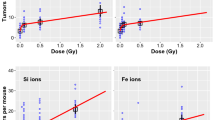Abstract
Exposures in space consist of low-level background components from galactic cosmic rays (GCR), occasional intense-energetic solar-particle events, periodic passes through geomagnetic-trapped radiation, and exposure from possible onboard nuclear-propulsion engines. Risk models for astronaut exposure from such diverse components and modalities must be developed to assure adequate protection in future. NASA missions. The low-level background exposures (GCR), including relativistic heavy ions (HZE), will be the ultimate limiting factor for astronaut career exposure. We consider herein a two-mutation, initiation-promotion, radiation-carcinogenesis model in mice in which the initiation stage is represented by a linear kinetics model of cellular repair/misrepair, including the track-structure model for heavy ion action cross-sections. The model is validated by comparison with the harderian gland tumor experiments of Alpen et al. for various ion beams. We apply the initiation-promotion model to exposures from galactic cosmic rays, using models of the cosmic-ray environment and heavy ion transport, and consider the effects of the age of the mice prior to and after the exposure and of the length of time in space on predictions of relative risk. Our results indicate that biophysical models of age-dependent radiation hazard will provide a better understanding of GCR risk than models that rely strictly on estimates of the initial slopes of these radiations.
Similar content being viewed by others
References
Alpen EL, Powers-Risius P, Curtis SB, DeGuzman R (1993) Tumorgenic potential of high Z, high LET, charged particle radiations. Radiat Res 136:382–391
Alpen EL, Power-Risius P, Curtis SB, DeGuzman R, Fry RJM (1994) Fluence based relative biological effectiveness for charged particle carcinogenesis in mouse harderian gland. Adv Space Res 14:573–582
Armitage P, Doll R (1957) A two-stage theory of carcinogenesis in relation to the age distribution of human cancer. Br J Cancer 11:161–169
Cucinotta FA, Wilson JW (1994) An initiation-promotion model of tumor prevalence from high charge and energy radiations. Phys Med Biol 39:1811–1831
Curtis SB, Townsend LW, Wilson JW, Powers-Risius P, Alpen EL, Fry RJM (1992) Fluence-related risk coefficients using the harderian gland data as an example. Adv Space Res 12:407–416
Felber M, Burns FJ, Garte SJ (1992) Amplifications of thec-myc oncogene in radiation-induced rat skin tumors as a function of linear energy transfer and dose. Radiat Res 131:297–301
Fry RJM, Staffeldt E, Tyler SA (1978) Some problems in analyses of large-scale animal irradiation experiments. Environ Int 1:361–366
Guerro I, Villansante A, Corces V, Pellicier A (1984) Activation of ak-ras oncogene by somatic mutation in mouse lymphomas induced by gamma-ray radiation. Science 225:1159–1162
Katz R, Ackerson B, Homayoonfar M, Scharma SC (1971) Inactivation of cells by heavy ion bombardment. Radiat Res 47:402–425
Land H, Paranda LF, Weinberg RA (1983) Cellular oncogenes and multi-step carcinogenesis. Science 222:771–778
Mitchel REJ, Trivedi A (1993) Radiation: what determines the risk? In: Swenberg CE, Horneck G, Stassinopoulos EG (eds) Biological effects and physics of solar and galactic cosmic radiation. Plenum Press, New York, pp 859–870
Moolgavkar SH, Knudson AG (1981) Mutation and cancer: a model for human carcinogenesis. JNCL 66:1037–1051
Tsuboi K, Yang TC, Chen DJ (1992) Charged particle mutagenesis I: cytoxic and mutagenis effects of high LET charge iron particles on human skin fibroblasts. Radiat Res 129:171–176
Wilson JW, Townsend LW, Schimmerling W, Khandelwal GS, Khan F, Nealy JE, Cucinotta FA, Simonsen LC, Shinn JL, Norbury JW (1991) Transport methods and interactions for space radiations. NASA RP 1257
Wilson JW, Cucinotta FA, Shinn JL (1993) Cell kinetics and track structure. In: Swenberg CE, Horneck G, Stassinopoulos EG (eds) Biological effects and physics of solar and galactic cosmic radiation. Plenum Press, New York, pp 295–338
Author information
Authors and Affiliations
Rights and permissions
About this article
Cite this article
Cucinotta, F.A., Wilson, J.W. Initiation-promotion model of tumor prevalence in mice from space radiation exposures. Radiat Environ Biophys 34, 145–149 (1995). https://doi.org/10.1007/BF01211540
Received:
Accepted:
Issue Date:
DOI: https://doi.org/10.1007/BF01211540




